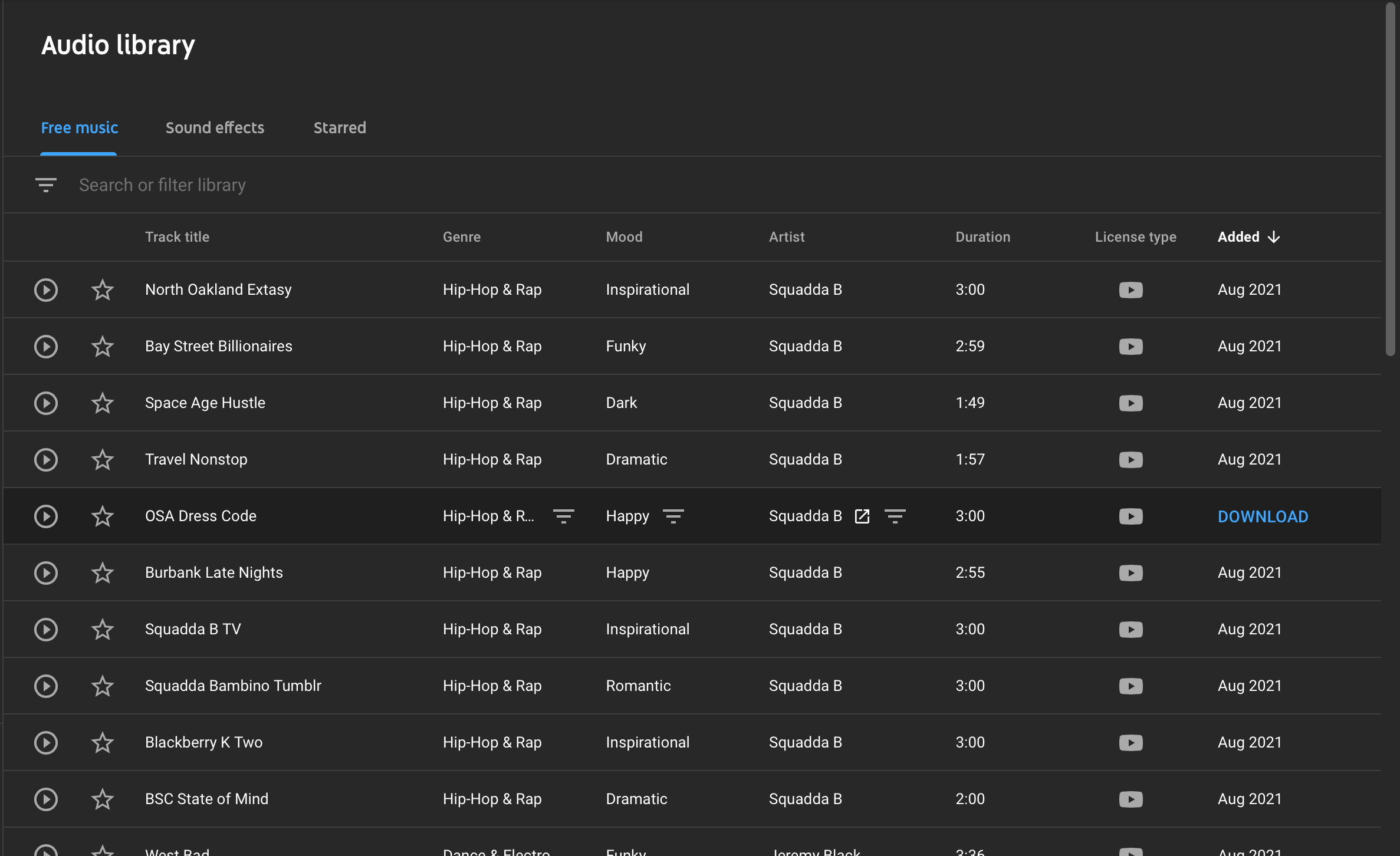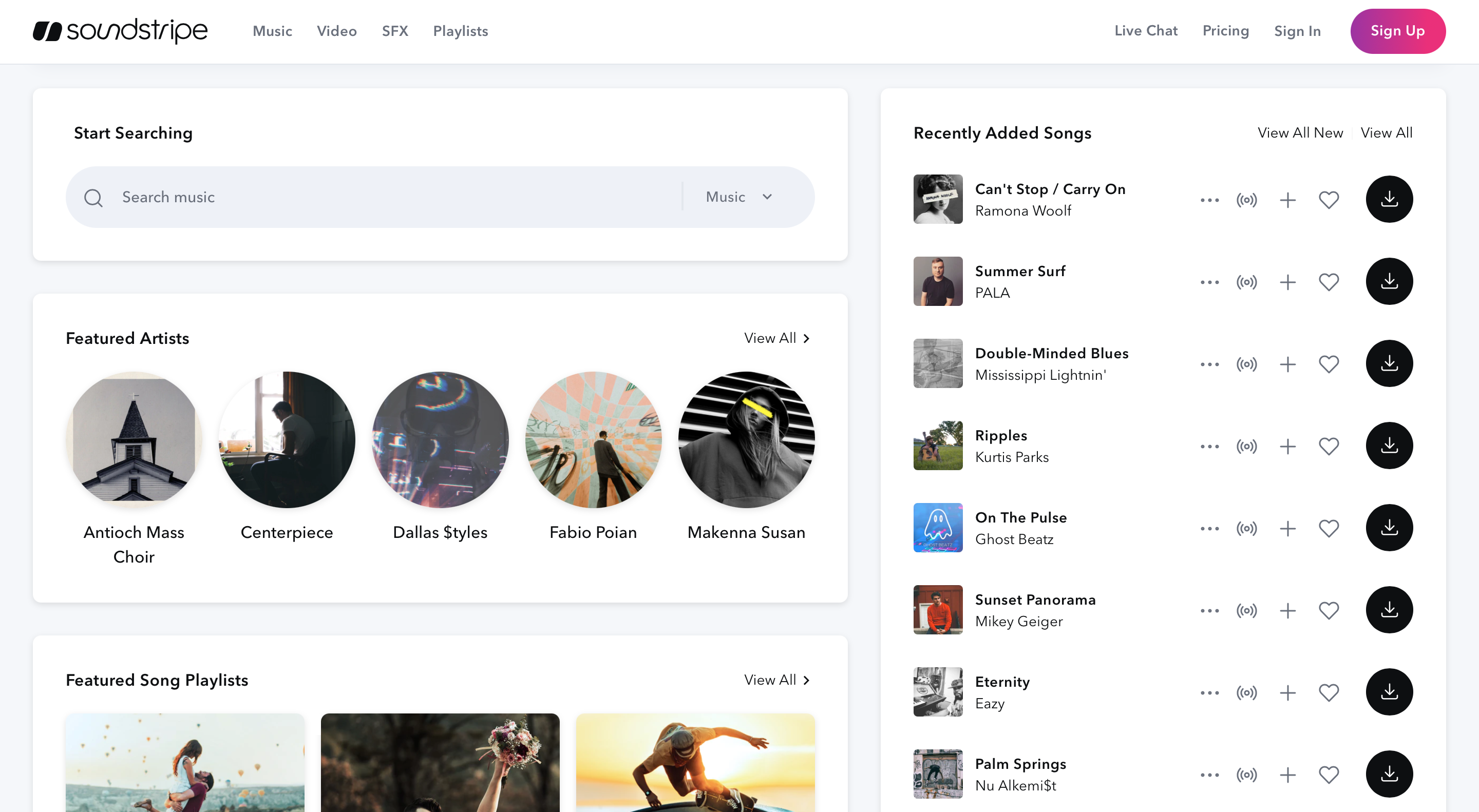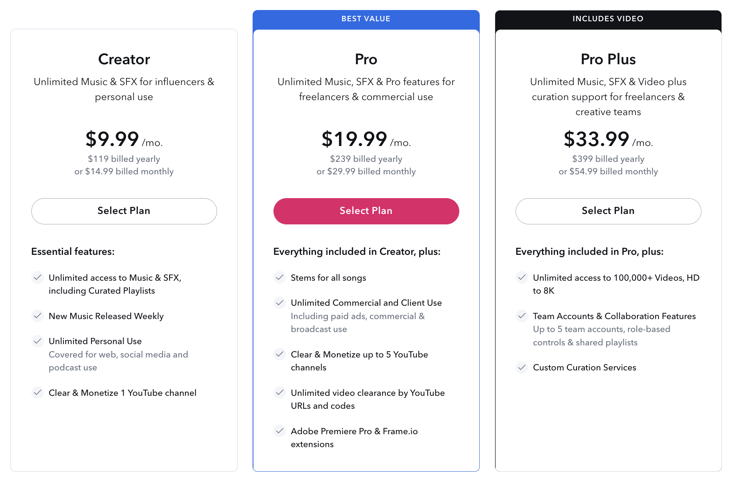*Updated March 2022
Keeping tabs on what’s new in the music streaming and licensing industry isn’t always easy. New services pop up every day, which gives you a plethora of options that — though great to have — can be overwhelming to sort through.
Sometimes, all you really want is to listen to some quality music. Other times, you might be looking for a specific type of song to license for an upcoming creative project.
Whatever the case may be, you could spend hours sifting through review sections, pricing pages, and features to narrow down on the best options. (That’s a lot of tabs to have open in your browser at one time.)
Getting a simple and straightforward breakdown of your options isn’t too much to ask for, which is why we’ve written up this article to compare Soundstripe and YouTube Audio Library.
If you’ve been on the fence about using either service, you’ll walk away with more information and clarity to decide what your next move should be.
First Things First — What Are You Looking For?
- A streaming service?
- A hub for popular music?
- A licensing service?
- All of the above?
Everyone has different priorities when it comes to streaming music, and you know your preferences better than anyone else.
Any music streaming service that you use needs to meet your standards for quality, but also practical use.
If you’re a corporate advertiser or wedding filmmaker that wants to not only listen to but license music for commercial use, then you’ll want a service that allows you to do that.
If you just want to jam out on your morning commute to good music, the same principle holds true.
A great streaming service for someone else might not check off all the boxes for you, and vice versa. So, with that in mind, let’s take a closer look at your options.
Let’s Break Down YouTube Audio Library vs. Soundstripe
YouTube launched its Audio Library in 2013 as a resource for content creators to get music and sound effects for their projects.
Given that both YouTube Audio Library and Soundstripe are hubs for licenseable royalty free media, it’s only natural to wonder which one is better. More specifically, how does the Audio Library stack up against Soundstripe?
Before we compare the two services, let’s first make an important distinction between YouTube Music and YouTube Audio Library:
- YouTube Music is a streaming service for mainstream music. This app officially replaced the formerly active Google Play Music app in 2020. You can listen to your favorite artists, watch music videos, and listen to playlists all in the same place.
- YouTube Audio Library, on the other hand, is for content creators who want to use royalty free music in their creative projects. So long as you attribute the creator and abide by a few very specific rules, you have the go-ahead to use the music.
 YouTube Audio Library
YouTube Audio Library
If you were to combine these two platforms, you would get something similar to a service like Soundstripe. And here’s why.
With Soundstripe, you can stream and license any and all of the 7,000+ royalty free songs in the music catalog.
 Soundstripe's music library
Soundstripe's music library
Unlike YouTube Audio Library, there aren’t any attribution hoops to jump through when you license music through Soundstripe. Plus, you get perpetual coverage, so you won’t have to repeat the whole licensing process every few years.
With that in mind, let’s discuss the key similarities and differences between Soundstripe and YouTube Audio Library in terms of cost, music variety, and attribution.
Cost
If you want to test the waters with both services, the good news is that Soundstripe and YouTube Audio Library both offer a way to do so for free.
When you sign up for a free Soundstripe account, you can stream any song, build custom playlists, favorite songs and artists, and even get watermarked previews of songs.
And if you upgrade to a paid subscription, you unlock unlimited access to music and sound effects starting at $9.99/month. This lets you find and license any song from the app in five minutes or less.
 Soundstripe's pricing plans
Soundstripe's pricing plans
While YouTube Audio Library is always free for creators to use, there’s a caveat.
When you find a song or sound effects that you want to use in your video's intro, for example, you have to jump through a few more hurdles and follow strict attribution conditions (more on that later).
So while you might save some money every month, you lose the flexibility to license music on the spot and immediately use it in any project — on or off YouTube.
Music Variety
When it comes to music variety, there are a few key differences between Soundstripe and YouTube Audio Library.
For one, YouTube Audio Library adds new music twice a month whereas Soundstripe adds new music and sound effects on a weekly basis. So if you want more new music to choose from every week, that’s something you can’t get with YouTube’s service.
Another key difference lies with the filter functions.
With Soundstripe, you have the option to add but also exclude as many filters as you want. Because there are a dozen different filter categories to work with (instead of eight with YouTube Audio Library), your search is more curated to your specific music tastes.
The goal is to help you find the right song and then add that music to your project as easily as possible.
Attribution
With YouTube Audio Library, attributions are non-negotiable unless specified otherwise.
To use an artist’s music in your YouTube video, you have to include the full attribution in the video’s description. And to use the music in a project outside of YouTube, you have to contact the artist directly to get permission.
Not only could this take up a lot of time you don’t necessarily have, it’s possible that you won’t get approval to use the music in your non-YouTube related content at the end of negotiations.
When you license music with Soundstripe, however, all you need to do is download and go — no attributions or negotiations involved.
The only added step is submitting a cue sheet if you plan on using the media in TV or film.
Do More Than Listen to Music
Today’s content creators want secure and streamlined licensing, which isn’t too much to ask for.
While there are perks to using YouTube Audio Library (the price tag being the main one), what you can do with the music after you press download is limited.
Not to mention, there’s no way to know whether your request to use a song outside of YouTube will be approved instantly or denied weeks later.
By licensing music and sound effects with Soundstripe, you take the guesswork out of this entire process because the steps are simple.
- Find the music or media you like.
- Download.
- Fill out and submit a cue sheet (if applicable).
From there, you’ll be able to easily integrate the song into your YouTube video, podcast episode, short film, or other project and share it with your audience without fear of copyright strikes or DMCA notices.

